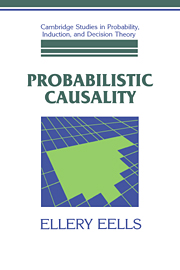Book contents
- Frontmatter
- Contents
- Preface
- Introduction
- Chapter 1 Populations and probability
- Chapter 2 Spurious correlation and probability increase
- Chapter 3 Causal interaction and probability increase
- Chapter 4 Causal intermediaries and transitivity
- Chapter 5 Temporal priority, asymmetry, and some comparisons
- Chapter 6 Token-level probabilistic causation
- Appendix 1 Logic
- Appendix 2 Probabilit
- Bibliography
- Index
Chapter 4 - Causal intermediaries and transitivity
Published online by Cambridge University Press: 07 October 2009
- Frontmatter
- Contents
- Preface
- Introduction
- Chapter 1 Populations and probability
- Chapter 2 Spurious correlation and probability increase
- Chapter 3 Causal interaction and probability increase
- Chapter 4 Causal intermediaries and transitivity
- Chapter 5 Temporal priority, asymmetry, and some comparisons
- Chapter 6 Token-level probabilistic causation
- Appendix 1 Logic
- Appendix 2 Probabilit
- Bibliography
- Index
Summary
In Chapter 2, a spurious correlation of a factor Y with a factor X was characterized as a situation in which, because of separate causes of Y, the degree of correlation of Y with X is different from the degree of causal significance of X for Y. The possibility of a spurious correlation of Y with X was diagnosed as arising when there are factors Z that are correlated with X and that are positive, negative, or mixed causes of Y, independently of X, where the correlation in question may be unconditional or conditional on other such factors Z. But as noted in Chapter 2, not all cases in which X is correlated with separate causes of Y give rise to a spurious correlation: The separate causes must be causally independent of X. In Chapter 3, we saw that when a factor X interacts, with respect to a factor Y, with a factor Z that is causally independent of X, then we should say that X is causally mixed for Y. But as noted in Chapter 3, not all cases in which a factor X interacts with a factor Z in the production of a factor Y are cases of mixed causal relevance of X for Y. Again, Z must be causally independent of X.
- Type
- Chapter
- Information
- Probabilistic Causality , pp. 169 - 238Publisher: Cambridge University PressPrint publication year: 1991

